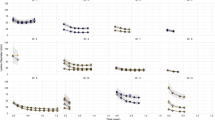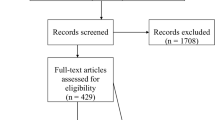Abstract
Purpose
To compare lesion-level and volumetric measures of tumor burden with sum of the longest dimensions (SLD) of target lesions on overall survival (OS) predictions using time-to-growth (TTG) as predictor.
Methods
Tumor burden and OS data from a phase 3 randomized study of second-line FOLFIRI ± aflibercept in metastatic colorectal cancer were available for 918 patients out of 1216 treated (75%). A TGI model that estimates TTG was fit to the longitudinal tumor size data (nonlinear mixed effect modeling) to estimate TTG with: SLD, sum of the measured lesion volumes (SV), individual lesion diameters (ILD), or individual lesion volumes (ILV). A parametric OS model was built with TTG estimates and assessed for prediction of the hazard ratio (HR) for survival.
Results
Individual lesions had consistent dynamics within individuals. Between-lesion variability in rate constants was lower (typically < 27% CV) than inter-patient variability (typically > 50% CV). Estimates of TTG were consistent (around 12 weeks) across tumor size assessments. TTG was highly significant in a log-logistic parametric model of OS (median over 12 months). When individual lesions were considered, TTG of the fastest progressing lesions best predicted OS. TTG obtained from the lesion-level analyses were slightly better predictors of OS than estimates from the sums, with ILV marginally better than ILD. All models predicted VELOUR HR equally well and all predicted study success.
Conclusion
This analysis revealed consistent TGI profiles across all tumor size assessments considered. TTG predicted VELOUR HR when based on any of the tumor size measures.


Similar content being viewed by others
References
Bruno R, Mercier F, Claret L (2014) Evaluation of tumor-size response metrics to predict survival in oncology clinical trials. Clin Pharmacol Ther 95:386–393
Venkatakrishnan K, Friberg LE, Ouellet D et al (2015) Optimizing oncology therapeutics through quantitative clinical pharmacology: challenges and opportunities. Clin Pharmacol Ther 97:37–54
Claret L, Girard P, Hoff PM et al (2009) Model-based prediction of phase III overall survival in colorectal cancer on the basis of phase II tumor dynamics. J Clin Oncol 27:4103–4108
Claret L, Gupta M, Han K et al (2013) Evaluation of tumor size response metrics to predict overall survival in western and Chinese patients with first line metastatic colorectal cancer. J Clin Oncol 31:2110–2114
Sharma MR, Gray E, Goldberg RM et al (2015) Resampling the N9741 trial to compare tumor dynamic versus conventional end points in randomized phase II trials. J Clin Oncol 33:36–41
Venook AP, Tabernero J (2015) Progression-free survival: helpful biomarker or clinically meaningless end point? J Clin Oncol 33:4–6
Therasse P, Arbuck SG, Eisenhauer EA et al (2000) New guidelines to evaluate the response to treatment in solid tumors. J Natl Cancer Inst 92:205–216
Li CH, Bies RR, Wang Y et al (2016) Comparative effects of CT imaging measurement on RECIST end points and tumor growth kinetics modeling. Clin Transl Sci 9(1):43–50
Zhao B, Lee SM, Lee HJ et al (2014) Variability in assessing treatment response: metastatic colorectal cancer as a paradigm. Clin Cancer Res 20(13):3560–3568
Van Cutsem E, Tabernero J, Lakomy R et al (2012) Addition of aflibercept to fluorouracil, leucovorin, and irinotecan improves survival in a phase III randomized trial in patients with metastatic colorectal cancer previously treated with an oxaliplatin-based regimen. J Clin Oncol 30:3499–3506
Tabernero J, Van Cutsem E, Lakomý R et al (2014) Aflibercept versus placebo in combination with fluorouracil, leucovorin and irinotecan in the treatment of previously treated metastatic colorectal cancer: prespecified subgroup analyses from the VELOUR trial. Eur J Cancer 50:320–331
Yang H, Schwartz LH, Zhao B (2016) A response assessment platform for development and validation of imaging biomarkers in oncology. Tomography 2(4):406–410
Tan Y, Schwartz LH, Zhao B (2013) Segmentation of lung lesions on CT scans using watershed, active contours, and Markov random field. Med Phys 40(4):043502
Yan J, Schwartz LH, Zhao B (2015) Semi-automatic segmentation of liver metastases on volumetric CT images. Med Phys 42(11):6283–6293
Tan Y, Lu L, Bonde A, Wang D at al (2018) Lymph node segmentation by dynamic programming and active contours. Med Phys. https://doi.org/10.1002/mp.12844
Savic RM, Karlsson MO (2009) Importance of shrinkage in empirical Bayes estimates for diagnostics: Problems and solutions. AAPS J 11:558–569
Akaike H (1974) A new look at the statistical model identification. IEEE Trans Autom Control 19:716–723
Schindler E, Krishnan SM, Mathijssen RHJ et al (2017) Pharmacometric modeling of liver metastases’ diameter, volume, and density and their relation to clinical outcome in imatinib-treated patients with gastrointestinal stromal tumors. CPT Pharmacomet Syst Pharmacol 6:449–457
Zheng Y, Narwal R, Jin C, Baverel PG et al (2018) Population modeling of tumor kinetics and overall survival to identify prognostic and predictive biomarkers of efficacy for durvalumab in patients with urothelial carcinoma. Clin Pharmacol Ther 103:643–652
Desmée S, Mentré F, Veyrat-Follet C, Guedj J (2015) Nonlinear mixed-effect models for prostate-specific antigen kinetics and link with survival in the context of metastatic prostate cancer: a comparison by simulation of two-stage and joint approaches. AAPS J 17:691–699
Acknowledgements
The authors are indebted to Prof. A Iliadis, Aix-Marseille University, Marseille, France for scientific discussions during the course of this work; and to Mathilde Marchand, Certara Consulting Services, France for careful review of the analyses.
Funding
This study was supported by the NIH Grant R01CA194783.
Author information
Authors and Affiliations
Corresponding author
Ethics declarations
Conflict of interest
Laurent Claret and Rene Bruno were employees of Pharsight Consulting Services, Pharsight, a Certara™ Company, when this work was performed. They are now employees of Genentech-Roche. Binsheng Zhao owns patents on tumor segmentation algorithms used in this work and has received royalties from Varian Medical Systems and Keosys Medical Imaging companies. Lawrence H. Schwartz received consulting fees from Merck, Novartis; and Research support from Daichi Sankyo and Eli Lilly. All other authors have no conflict of interest.
Ethical approval
This article does not contain any studies with animals performed by any of the authors. All procedures performed in studies involving human participants were in accordance with the ethical standards of the institutional and/or national research committee and with the 1964 Helsinki declaration and its later amendments or comparable ethical standards. Informed consent was obtained from all individual participants included in the study.
Electronic supplementary material
Below is the link to the electronic supplementary material.
Rights and permissions
About this article
Cite this article
Claret, L., Pentafragka, C., Karovic, S. et al. Comparison of tumor size assessments in tumor growth inhibition-overall survival models with second-line colorectal cancer data from the VELOUR study. Cancer Chemother Pharmacol 82, 49–54 (2018). https://doi.org/10.1007/s00280-018-3587-7
Received:
Accepted:
Published:
Issue Date:
DOI: https://doi.org/10.1007/s00280-018-3587-7




